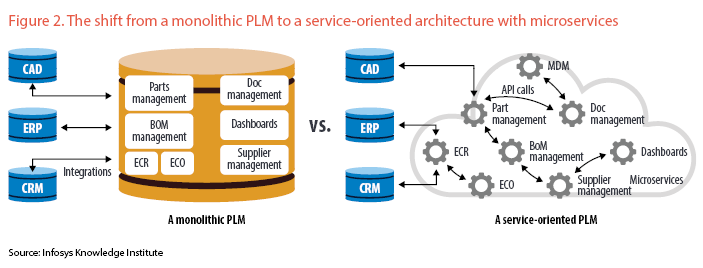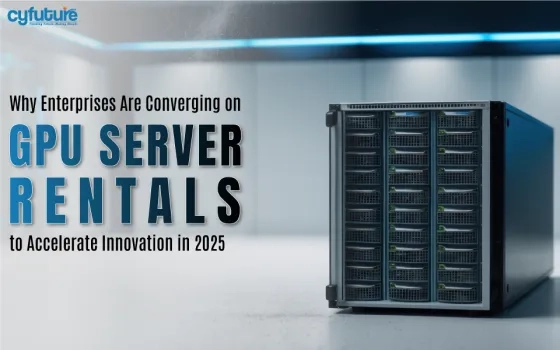The manufacturing industry faces tremendous pressure to change from both the supply and the demand sides. On the supply side, companies need to collaborate with multiple partners to develop products faster, while still offering traceability and meeting regulations. On the demand side, customers insist on better-performing products that are still affordable — and they want them quickly.
These pressures have been building for years. But the need to shift strategies reached a peak with the COVID-19 pandemic. Engineers were forced out of their offices, and manufacturers had to rethink how they operated.
In many cases, manufacturers turned to the cloud — and the digital technologies it can enable — to improve new product development and accelerate time to market. The Infosys Cloud Radar 2021 report found that among discreet manufacturers, new product development is the second-most-popular cloud use case, followed only by visibility into shop-floor quality.1 This kind of pivot was seen in even the most sophisticated and mature companies.
New product development is the second-most popular use case for cloud adoption in discrete manufacturing, according to the Infosys Cloud Radar 2021 study.
Toyota is famous for its engineering prowess, but the automaker’s well-established processes were severely challenged during the COVID-19 pandemic.2 The engineering design group traditionally used advanced software running on powerful workstations in the office. When that was not possible, Toyota developed a virtual desktop infrastructure in the cloud that allowed engineers to work remotely on high-performance applications, such as 3D CAD (computer-aided design).
This setup was needed to manage an immediate crisis, but Toyota discovered that there were longer-term benefits. This offered employees the flexibility to work from anywhere and with any team, consolidated computing for better utilization, and reduced the number of workstations by half to save cost.
Product life cycle in the cloud
The migration to the cloud has been a slow one for the manufacturing sector, which has trailed almost every other industry in the adoption of cloud technology. IDC’s cloud spending guide found that SaaS (software as a service) accounted for just one-quarter of all enterprise applications among manufacturers. Only the government sector was lower.3
Manufacturers were hesitant to use the cloud for new product design and associated engineering tasks for many reasons, including concerns about the security of their data and intellectual property (IP).4 Also, increasingly complex regulations govern how data is stored, particularly when it is safeguarded off-site. Companies have also encountered technical hurdles, including integrating product development systems with other enterprise applications, portability across systems, system availability, and performance.
Now these manufacturers have indicated that they plan to accelerate this transition significantly. The pandemic — coupled with advances in cloud computing and the increasing complexity of products — created a tipping point for cloud-based product development.5 The benefits of the cloud have been amplified by the need for remote working and collaboration across functions, departments, locations, and even organizations. Applications across the entire product life cycle can be securely accessed from anywhere and on any device. Other benefits include elasticity of computing, flexibility to integrate with other applications, and cost savings.
The dramatic improvements in network bandwidth, computing, and storage have also accelerated this change, according to Jim Heppelmann, CEO and president of software company PTC. His firm projects that the SaaS market for CAD will grow at a 35% year-over-year rate and reach a 20% market share by 2024.6
However, to gain the greatest benefit, businesses need to rethink how they work. Legacy applications, infrastructure, data, and workflows should be standardized, simplified, and then migrated to the cloud. Employees need to train to work in synchronous and collaborative ways and to use new functionalities and live product performance data in the design process.
For manufacturers, the benefits of a cloud-based infrastructure need not be limited to specific areas in the life cycle of a product. Companies should migrate their entire product life cycle to the cloud for maximum benefit. Their three most important areas are design to engineering, engineering to manufacturing, and the aftermarket (see Figure 1). For each, the cloud can offer benefits, such as breaking up siloes and allowing applications to communicate seamlessly, that go beyond manufacturers’ traditional approaches.

Recent cloud developments
For manufacturers, few tools are more important than their product lifecycle management (PLM) software for new product development. PLM in the cloud acts as a master database for parts and a front end for the CAD tools used to design those parts.
CAD and PLM in the cloud enable new features and capabilities that were not possible previously due to cost or computing constraints. They enable real-time collaboration; multiple teams can simultaneously view a part and its bill of materials and add their comments to provide feedback.
Optimized part geometry
General Motors took advantage of these new features to reduce vehicle weight by redesigning its parts. The automaker uses cloud-based computing for its “generative design” capabilities. The cloud-based approach — paired with machine learning — optimizes part geometry for parameters including weight, strength, choice of material, and manufacturing method.
The application creates several part designs based on the goals and constraints set by the designer, who then has final say on the best design.7 A seat bracket that used generative design consolidated eight parts into one, which was 40% lighter and 20% stronger.
Supplier collaboration
Suppliers play a key role in the timely development and delivery of parts and systems. To avoid delays, manufacturers need to collaborate early in the product life cycle and help suppliers develop their infrastructure and skills in emerging areas.
Jaguar Land Rover (JLR) faced delays in its vehicle launch initiatives last year. During the COVID-19 pandemic, the automaker launched a digitization program to increase speed and improve quality in its new product process.8 The company onboarded its suppliers to a PLM platform and provided them with a cloud-based engineering toolkit that featured three levels of complexity:
- A basic CAD data exchange.
- Synchronous parts design.
- A comprehensive design, analysis, simulation, and manufacturing environment.
Adoption of PLM helped JLR reduce by up to 40% the time needed for some specific product development roles. For JLR’s suppliers, these changes facilitated remote working, reduced the waiting time for information, avoided rework by providing accurate information, and offered a secure environment for vehicle design programs.
Microservices integration
Companies traditionally developed PLM as one large monolithic application that features all functionalities. This approach makes upgrades to PLM and integration with other enterprise applications a challenge. However, companies can instead use a group of independent and loosely coupled, cloud-native microservices. With technology-agnostic communication protocols, the application programming interfaces (APIs) can talk to each other more easily (see Figure 2).
In a GE Power report, the company lists “failure isolation” as a reason for the adoption of cloud-native microservices, over and beyond the speed of innovating and implementing applications in the cloud. Microservices enable small teams to rapidly deliver new capabilities and enhance existing services with code reuse and minimal impact on existing business processes. GE Power found that provisioning a new application by calling a cloud-based API is faster than the traditional process by several orders of magnitude.9

Better security with DRM
When designing parts, manufacturers must carefully protect their IP — even the geometry of critical parts is sensitive. Digital rights management (DRM) restricts access to designs, while watermarks on CAD files ensure that even if they are copied, the IP is protected.
These same protections are available and are often more robust in cloud-based systems. DRM applications in PLM packages ensure that files are encrypted before they are shared among employees, suppliers, and partners. The user’s role determines the ability to view, edit, and copy files. In these systems, a DRM key must be acquired from a central server each time a file is accessed. This ongoing monitoring allows companies to react quickly to violations or vulnerabilities.
Table 1. Comparison of traditional and cloud-based product development across the life cycle
|
Stage in product development
|
Ideation and preliminary design
|
Detailed design
|
Validation and testing
|
Release to manufacture
|
Ongoing improvements
|
|
Traditional way
|
Sequential among teams, with dedicated, rigid access-controlled computing.
|
Ability to work on one design at a time.
|
Lack of traceability from one siloed system to another.
|
Location-specific MBOM in each instance of ERP.
|
Lack of feedback from sold products.
|
|
Cloud-based
|
Concurrent with multiple users working simultaneously at all stages; remote, flexible access from any device.
|
Multiple design iterations at the same time to optimize part geometry.
|
Traceability of part history with one central flow; integrated authoring of documents.
|
Centralized and synchronized PLM for EBOM and MBOM.
|
Closed-loop with IoT data feed for product performance.
|
|
(MBOM — Manufacturing bill of materials; EBOM — Engineering bill of materials)
|
A holistic cloud approach
The recent crisis has forced companies to rethink their businesses, from supply chains to workplaces. Many of those changes have led companies to the cloud, where the skepticism of the past has fallen aside. Traditional organizations should think, plan, and mimic a cloud-native approach to fully exploit the advantages it offers. The cloud should not be seen as just an alternate way of computing but as a much more capable platform. Cloud-native enterprises have the opportunity to design their IT infrastructure, business processes, and talent aligned with a cloud approach from the start.
Thanks to recent advances, many in the manufacturing sector have concluded that the advantages of a cloud-based CAD and PLM strategy far outweigh the challenges. Cloud-based design and product development offer features that were not feasible previously using on-premises computing — and they offer affordability.
Cloud-based new product development offers functionalities that were not feasible before with on-premise computing
However, companies should look at this change holistically rather than as just a one-time response to crisis. Organization still need to upskill their employees so they can work collaboratively across teams. Other computing infrastructure needs to migrate to the cloud. Manufacturers have made radical changes since 2020, but they still haven’t reached their destination. To do so, here are four recommendations to realize the benefits of new product development in the cloud:
- Adapt new product development for collaboration, not just among humans — also include algorithms such as generative design to increase inputs and aid decision-making.
- Democratize computing on the cloud and product modularity to grow the base of reliable third-party providers of product design for critical systems.
- Manufacturers should launch “explainable product design.” Provide rationale for parameters such as usage of rare materials or parameters that impact society (for example, greenhouse gas emissions, labor amount, and source of materials).
- Each new product should be expected to provide an estimate of circularity or materials reuse expected at the end of life along with an action plan to continuously improve it.
References
- Infosys Cloud Radar 2021, June 2021, Infosys.
- Toyota Motor Selects Nutanix Cloud Platform to Realize a New Way of Working, June 7, 2021, Businesswire.
- IDC Worldwide Public Cloud Services Spending Guide, 2018.
- Product Development in the Cloud: No Cause for Concern, Chris Holmes and Craig Stires, August 2014, IDC Manufacturing Insights.
- How Covid has pushed SaaS uptake to tipping point, Jim Heppelmann, March 26, 2021, The Institution of Engineering and Technology.
- Heppelmann and Hirschtick on PTC’s Acquisition of Onshape, Ralph Grabowski, Oct. 24, 2019, WorldCAD Access.
- Advanced Software Design Technology Leads GM into Next Generation of Vehicle Lightweighting, May 3, 2018, General Motors.
- Why suppliers should align their digitalisation strategy with Jaguar Land Rover, Oct. 29, 2020, Dassault Systemes.
- The Cloud Advantage, Six Reasons Power Leaders Are Moving to Cloud, 2015, GE Power.
Originally published at New Product Development In The Cloud (infosys.com)
Click through to know more about The Engineering Cloud (infosys.com)
About the Authors:
 Ramachandran S - Manufacturing and Engineering Lead, Infosys Knowledge Institute
Ramachandran S - Manufacturing and Engineering Lead, Infosys Knowledge Institute
 Kandhasami Palaniappan - PLM Service Offering Lead at Infosys
Kandhasami Palaniappan - PLM Service Offering Lead at Infosys







 Kandhasami Palaniappan - PLM Service Offering Lead at Infosys
Kandhasami Palaniappan - PLM Service Offering Lead at Infosys










